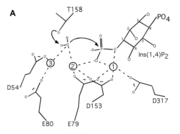This is a default text for your page Sandbox 1677. Click above on edit this page to modify. Be careful with the < and > signs.
You may include any references to papers as in: the use of JSmol in Proteopedia [1] or to the article describing Jmol [2] to the rescue.
Function of your protein
The protein 7KIR is found in the organism Bos taurus, is a a protype member of proteins dealing with inositol signaling. The function of is dephosphorylating inositol, used in inositol signaling, the substrate of the enzyme is IP3 and the product is IP2. The amino acids of the protein hold onto the magnesium metal ions that then hold onto the water molecule, this allows for it to take off a phosphate.
Biological relevance and broader implications
This protein is involved in dephosphorylation of inositol which inhibits inositol signaling in cattle. The two metal ions, Magnesium and Lithium, are particularly important in activation and inhibition of inositol signaling. Since these enzymes are seen in many different organisms, with slight mutations in the motif of the enzyme without change in function, understanding the mechanics of enzyme inhibition in this metabolic pathway would allow a better understanding of metabolic pathways.
Important amino acids
In the protein the substrate is , will be dephosphorylated by the water brought in by the magnesium ions.In this protein the amino acids do not interact with the substrate itself, instead they interact with the metal ions. When magnesium is present, and the protein therefore activated, the amino acids will hold onto the magnesium ions. These magnesium ions that interact with the inositol and water so that it can dephosphorylate the substrate. The motif of enzymes in this family is DPIDXT. In this particular protein the motif is . There are some mutations in the enzyme but the overall function of the protein is still the same.
Structural highlights
The protein has thirteen structural elements. The amino acids in the bind to the substrate all participate in hydrogen bonding to the substrate. The structure is , the betta sheets allow for twisting of the molecule so that the substrate better fits within the enzyme. The helices allow for hydrogen bonding throughout to stabilize the structure with assistance from metal ions; specifically magnesium ions. [3]
There is no quaternary structures in the protein but several that play an important role in the structure of the protein and therefore its function. There are many covalent bonds due to hydrophobic and nonpolar amino acids that form the structure. The amino acids involved with the , the magnesium ions assist in pulling the enzyme into shape that allow for it to be in the so that it can dephosphorylate the inositol. It wraps around the magnesium ions so that it can better attach to the water and then attack the phosphate on inositol. When the lithium ions interact with the enzyme a shape change occurs that will not allow for the magnesium ions to attach to the enzyme, and therefore the water molecules.
The rest of the enzyme is circled around the substrate which allows for a better ability to bind to the substrate, it is shown here how the how the nonpolar and polar amino acids allow for it to have this shape.
Other important features
The protein 7KIR is a protype member of proteins that work in inositol signaling, specifically dephosphorylating inositol to stop inositol signaling. The protein that the paper primarily mentions is , all of the proteins in this family share a motif, DPID X T. The X in the motif means that there can be any amino acid in there, in 1INP it is alanine while in is aspartic acid. The mutation in these proteins have no functional impact on the protein's ability to dephosphorylate inositol.
One of the unique things of this enzyme is its use of metal ions, the that then bind with the water. The water attacks the phosphate which causes the inositol to dephosphorylate the substrate as seen in the image to the right. The catalytic amino acids in enzyme are mainly polar which causes the magnesium ions to better bond with them.
This is a sample scene created with SAT to by Group, and another to make of the protein. You can make your own scenes on SAT starting from scratch or loading and editing one of these sample scenes.

